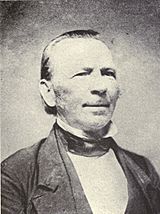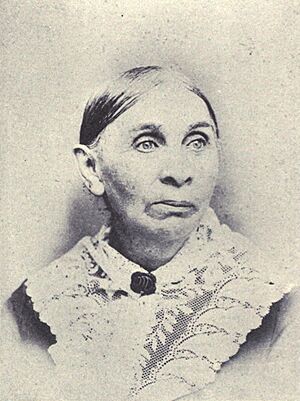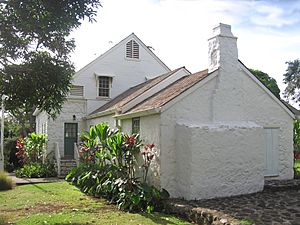Jonathan Smith Green facts for kids
Quick facts for kids
Jonathan Smith Green
|
|
|---|---|
 |
|
| Born | September 29, 1796 |
| Died | January 5, 1878 (aged 79) |
| Nationality | American |
| Occupation | Missionary |
| Spouse(s) | Theodosia Arnold Asenath Cargill Spring |
| Children | 6 |
| Parent(s) | Beriah and Elizabeth Green |
Jonathan Smith Green (born September 29, 1796 – died January 5, 1878) was a Christian missionary. He traveled from New England in the United States to the Kingdom of Hawaii.
Contents
Life and Mission Work in Hawaii
Jonathan Smith Green was born in Lebanon, Connecticut. This was on December 20, 1796. His parents were Beriah and Elizabeth Green. He studied at Andover Seminary. On September 20, 1827, he married Theodosia Arnold. She was from East Haddam, Connecticut.
Journey to Hawaii and Early Assignments
The Greens traveled to Honolulu in Hawaii. They arrived on March 30, 1828. They came on a ship called the Parthian. They were part of a group from the American Board of Commissioners for Foreign Missions. This group also included Lorrin Andrews and Gerrit P. Judd.
In 1829, Jonathan Green took a trip. He explored the Pacific Northwest coast of America. This was for the mission. The family was first sent to Lahaina, Hawaii on the island of Maui. They stayed there until 1831. Then they moved to Hilo, Hawaii for one year.
Building a Community in Wailuku
In 1833, the Green family moved back to Maui. They settled in Wailuku, Hawaii. There, they built one of the first permanent houses. This house is now known as the Bailey House Museum.
In 1836, the Greens started a school. It was a boarding school for girls. They named it the Wailuku Female Seminary.
Translating and Standing Up for Beliefs
Jonathan Green helped Lorrin Andrews translate the Bible. They translated it into the Hawaiian language. He also wrote the first book about the history of the Christian church in Hawaiian.
In 1842, Green and Andrews left the Congregational Church. They believed the church should take a stronger stand against slavery. Green even refused to wear cotton clothes. This was because cotton was often picked by enslaved people.
New Paths and Founding Churches
In 1843, Jonathan Green became an independent pastor. He also tried new things with farming. He was an early member of the Royal Hawaiian Agricultural Society. He even started a local group for it. He wrote reports about growing wheat and other crops. He grew them in higher, cooler areas.
In 1844, he wrote a book. It was about an early Hawaiian convert named Puaaiki. People called him "Blind Bartimeus." This was after a character in the Bible.
A local chief named Kiha suggested something to Green. He suggested founding an independent church. Green started the Poʻokela Church in Makawao, Hawaii. King Kamehameha III gave the land for it. Services were held in the Hawaiian language. The word Poʻokela means "foremost" or "excellent." The Poʻokela Church is located at 200 Olinda Road.
Family Life and Later Years
Jonathan Green's first wife, Theodosia, passed away in 1859. They had four children together. After her death, he traveled back to the mainland United States. In 1863, he married Asenath Cargill Spring. She was from Providence, Rhode Island.
Around 1857, Green began holding church services in English at his home. He started a group called the "Pāʻia foreign church." English was considered a "foreign language" in the Kingdom of Hawaii at that time. This church was closer to the sugarcane plantation near Pāʻia.
In April 1861, Prince Lot Kamehameha approved the church. He later became King Kamehameha V. The church was then named the Makawao Union Church.
In 1870, Henry Perrine Baldwin and his family joined the church. Henry played the organ there for over forty years. Henry Baldwin and his brother-in-law later became very successful. They co-founded the company Alexander & Baldwin.
Jonathan Smith Green passed away on January 5, 1878. His second wife, Asenath Green, continued to support the church. She did this until she died in 1894. Then, their daughters Mary and Laura helped maintain it. The Green family is buried at the Makawao Union Church cemetery.
Jonathan Green's Children
His son, Joseph Porter Green, was born on October 30, 1833. He also served at the church. In 1860, he was elected to the legislature of the Hawaiian Kingdom.
J. Porter Green married Hariette Fowler Parker in 1864. Their daughter, Mary Theodosia Green, married Henry Harrison Wilcox. Henry was the son of another missionary, Abner Wilcox. J. Porter Green died on June 26, 1886, in Honolulu.



